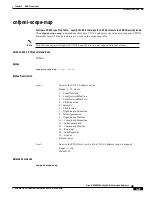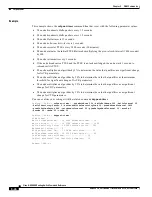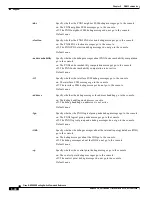
5-33
Cisco MGX 8850 Routing Switch Command Reference
Release 2.0, Part Number 78-10467-04 Rev C0, October 2001
Chapter 5
PNNI Commands
cnfpnni-pkttrace
cnfpnni-pkttrace
Configure PNNI Packet Trace
—
specify the parameters to trace packets.
This command applies to debugging. It causes the switch to check the PNNI packets transmitted and
received at each peer. For example, if an interface is not receiving user-traffic, you can execute
dsppnni-pktrace to display packet information that can help you find the level and type of blockage.
The cnfpnni-pkttrace command specifies the trace command examines the contents of PNNI packets
exchanged between two neighboring nodes. A PNNI packet consists of a Hello packet and the topology
information packets.
Note
Executing cnfpnni-pkttrace can significantly increase operational overhead, thereby degrading
network performance. You should consider executing this command while the node carries little or
no live traffic. If you execute cnfpnni-pkttrace while live traffic is present, you may want to
consider tracing the packets for one direction at a time (transmit or receive).
If you plan to use the optional -portId parameter but do not have the logical format of the port ID, use
dsppnport. For details, refer to the Syntax Description of cnfpnni-pkttrace.
Cards on Which This Command Runs
PXM45
Syntax
cnfpnni-pkttrace {tx {on|off} | rx {on|off} } [node-index [-portId port-id |
-svcIndex svc-index]]
Syntax Description
tx
Specify whether the switch traces transmitted packets.
on: Trace the transmitted packets
off: Do not trace the transmitted packets
Default: (no default)
rx
Specify whether the switch traces received packets.
on: Trace the received packets
off: Do not trace the received packets
Default = (no default)
node-index
In the current release, the only supported value for node-index 1. The node index
indicates the relative level of the logical node within a multi-peer group on the switch.
The range is 1–10, and the lowest level is 1.
Range: 1–10
Default = 1
















































